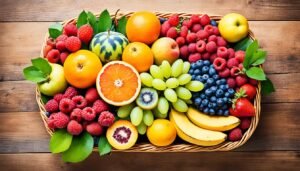Get our FREE E-Book HERE - 120 TIPS for Losing Weight & Bonus Tips for Postpartum Weight Loss & Dad’s Postpartum Experience
Calories: Understanding Energy in Food

Did you know that 11.3% of calories in the U.S. come from fast foods1? This fact shows how crucial calories are in our daily lives. They affect our health and well-being. Calories are the basic energy unit in food. Knowing about them helps you make better diet and weight choices.
This article will cover calories from different angles. We’ll talk about their sources, how they’re measured, and their role in managing weight. You’ll learn how to use calorie awareness for a healthy lifestyle. This way, you can make smart nutrition choices and control your health.
Key Takeaways
- Calories are the basic unit of energy in food, and understanding them is crucial for weight management and overall health.
- Fast foods contribute a significant portion of the total calorie intake in the U.S., highlighting the importance of making informed choices about your diet.
- The breakdown of caloric values per gram of food components is as follows: carbohydrates and protein provide 4 calories per gram, while fats contribute 9 calories per gram.
- Sugary drinks are a primary source of empty calories for many people in the U.S., and more than half of the population consumes at least one sugary drink per day.
- A large breakfast of around 700 calories is recommended for effective weight loss and to reduce the risk of chronic diseases like diabetes, heart disease, and high cholesterol.
What are Calories?
Calories measure the energy in food2. Our bodies turn food into energy for different body functions. Each gram of carbs and protein gives 4 calories, and fat gives 9 calories3.
Food Energy Measurement
Food energy is measured in kilocalories (kcal)2. This is the energy needed to heat one kilogram of water by one degree Celsius. Knowing this helps us figure out the calories in any food.
Kilocalories vs. Calories
“Kilocalories” and “calories” are the same thing3. A kilocalorie equals 1,000 calories. So, when you see “calories” on labels or in food talks, it means kilocalories.
Understanding calories and how they’re measured helps us make better food choices. This is key for our health and wellness2.
“Calories are the fundamental unit of energy in the foods we eat and the fuels our bodies burn.” – Nutrition Expert
Calorie Sources in Food

Carbohydrates, protein, and fats are the main sources of calories in our diet. Knowing about these can help you pick better foods and control your calorie intake4.
Carbohydrates
Carbs are key for energy. They include starches, sugars, and fiber. Each gram of carbs gives 4 calories, making them a great energy source4. You can find carbs in grains, fruits, veggies, and some dairy.
Protein
Protein is vital for fixing and building body tissues. It also has 4 calories per gram. Proteins can be complete or missing some amino acids. Good protein sources are lean meats, fish, eggs, dairy, beans, and some grains4.
Fats
Fats are crucial for storing energy, absorbing vitamins, and making hormones. They have the most calories at 9 per gram. But, eating too much fat isn’t good. Healthy fats are in nuts, seeds, avocados, olive oil, and fatty fish4.
Knowing about these nutrients helps you choose better foods for a balanced diet4.
| Food Item | Average Calorie Count |
|---|---|
| Apple (medium) | 725 |
| Bagel | 2895 |
| Banana (medium) | 1055 |
| Regular Beer (12 ounces) | 1535 |
| Bread (wheat or white, 1 slice) | 665 |
| Salted Butter (1 tablespoon) | 1025 |
| Carrots (raw, 1 cup) | 525 |
| Cheddar Cheese (1 slice) | 1135 |
| Chicken Breast (boneless, skinless, roasted, 3 ounces) | 1425 |
| Chili with Beans (canned, 1 cup) | 2875 |
This calorie chart shows the calories in common foods. It helps you make better meal choices and manage your calories5.
Understanding what foods give you calories helps you make better food choices. This leads to a healthier diet6.
Calorie Requirements and Weight Management
Keeping a healthy weight is all about balancing how many calories you eat and how many you burn. Your7 daily calorie needs depend on your age, gender, height, weight, and how active you are8. Women usually need 1,600 to 2,400 calories a day, and men might need 2,000 to 3,0009. Your Basal Metabolic Rate (BMR), which is about 60% of your daily calorie burn, also affects your calorie needs.
Daily Calorie Needs
To keep your weight the same, you need to eat the same number of calories as you burn each day9. If you’re not very active, you might need 1,600 to 2,400 calories a day if you’re a woman, or 2,000 to 3,000 if you’re a man7. But if you’re more active, you could need up to 2,400 calories for women and 3,000 for men7. The Calorie Calculator can give you a personalized estimate based on your details.
Calorie Balance for Weight Loss or Gain
To lose weight, you need to eat fewer calories than you burn7. Eating 500 fewer calories a day can help you lose 1 pound a week8. Eating more protein and cutting down on sugary drinks can also help with weight loss7. But losing more than 2 pounds a week can be bad for your health and might make you lose muscle, which can slow down your metabolism.
To gain weight, you need to eat more calories than you burn9. You can do this by adding 500 to 1,000 calories a day to your diet. Focus on eating nutrient-rich foods to support muscle growth and overall health.
Keeping a healthy weight is all about finding the right balance between what you eat and how active you are7. By knowing your calorie needs and adjusting your diet and exercise, you can reach your weight goals in a healthy way789.
Counting Calories

Tracking your calorie intake helps manage your weight and meet your body’s energy needs10. You can do this by reading nutrition labels, using apps, or following the USDA’s MyPlate guidelines10. Keeping an eye on calories lets you make smart food choices and reach your health goals.
One calorie is the energy needed to warm 1 kilogram of water by 1 degree Celsius10. Counting calories can help with weight loss by creating a calorie deficit – eating less than you burn10. The right calorie intake depends on your gender, age, weight, and activity level10.
Apps like My Fitness Pal and Lose It! help track calories10. Accurate food portion sizes are key to effective calorie counting10. Using everyday items to estimate food portions makes it easier10.
Eating whole, high-quality foods is better for your health and weight management10. Successful calorie counting means planning, reading labels, cutting unhealthy foods, losing weight slowly, and exercising10.
Reducing your daily calorie intake by 500 can lead to losing ½ to 1 pound a week11. Different brands have varying calorie counts, like in flavored lattes versus black coffee and chocolate ice cream versus strawberries11. Smaller portions mean fewer calories, like comparing 8 ounces of orange juice to 4 ounces11.
The recommended daily calories are 2,500 for men and 2,000 for women12. Losing weight by creating a 600kcal deficit daily can be effective12. Food labels can vary by up to 20% from stated amounts12. Keeping track of calories helps with weight loss and sticking to diets12.
Calorie figures aren’t exact, and daily needs can change12. Setting dietary goals based on personal changes, not just calories, is better12. Planning meals and having ingredients ready helps with healthy eating12. A balanced diet and avoiding strict diets are key for health12.
“Calorie counting is a powerful tool for weight management, but it’s not the only factor. A balanced, nutritious diet and regular exercise are also essential for long-term health and well-being.”
How Many Calories Should You Eat?
Factors Affecting Calorie Needs
Your daily calorie intake depends on your age, gender, height, weight, and how active you are13. Generally, adults need between 1,600 and 3,000 calories a day13. Your Basal Metabolic Rate (BMR) is a big part of your energy use, making up 60% to 70% of it13.
Other things can change how many calories you need, like your muscle mass, hormones, and health goals13. For example, eating 500 fewer calories a day can help you lose 1 pound a week13. But eating less than 1,200 calories a day might not give you all the nutrients you need13.
On average, people burn 1,300 to 2,000 calories a day without exercise13. Women and those assigned female at birth need 1,600 to 2,400 calories a day14. Men and those assigned male at birth need 2,200 to 3,000 calories14. These numbers can change based on your age, how active you are, and your health14.
Think about all these factors when figuring out how many calories you need for weight management and health13. Talking to a healthcare professional can help you make a calorie plan that fits your goals and needs13.
“Calories are not created equal, and the quality of the calories you consume is just as important as the quantity.”
Knowing what affects your calorie needs helps you make better diet choices. This can lead to a healthy weight and better health131415.
Calories and Nutrition Labels

Nutrition labels on food packaging are key to managing your calorie intake. They show the calorie and nutrient content of a product. This helps you make better choices about what you eat16.
These labels list the total calories per serving and break down calories from carbs, protein, and fat. It’s important to know how to read this info to keep a balanced diet and reach your health goals16.
Labels also show %Daily Values (%DV) for nutrients, showing how much a serving gives you. Foods with 5% DV or less of a nutrient are low, and 20% DV or more is high16. This helps you balance your nutrient intake throughout the day17.
| Nutrient | Low %DV | High %DV |
|---|---|---|
| Saturated Fat, Sodium, Added Sugars | 5% or less | 20% or more |
| Dietary Fiber, Vitamin D, Calcium, Iron, Potassium | 5% or less | 20% or more |
Nutrition labels also tell you how many servings are in a package and the serving size. This helps you understand the calorie and nutrient content of the whole product16.
By looking at nutrition labels, you can spot high-calorie, high-fat, or high-sodium foods. This lets you make choices that fit your health and wellness goals1718.
Some food packages also have front-of-pack labels for a quick look at nutritional info. These labels use colors to show if a product is high, medium, or low in nutrients like fat, sugar, and salt18.
Understanding nutrition labels helps you know the calorie and nutrient content of your food. This lets you make healthier choices for your well-being16.
“Nutrition labels are your personal guide to making smart and healthy food choices. Take the time to read them and understand what you’re putting into your body.”
The Role of Calories in a Balanced Diet

Calories are key to a balanced and nutritious diet. The USDA’s MyPlate guidelines help you build healthy meals. They suggest filling half your plate with fruits and veggies, a quarter with grains, and a quarter with protein19. Adding dairy and healthy oils is also important19. By watching your calorie intake, you can make sure you get the energy and nutrients your body needs.
MyPlate Guidelines
The plate method from USDA’s “ChooseMyPlate” means filling half the plate with fruits and veggies, and about a quarter with grains and protein foods20. You should also add dairy or a nondairy option on the side20. This way, you get all the important nutrients like vitamins, minerals, and healthy fats21.
- Fruits and Vegetables: Aim for 2-3.5 cups per day19
- Grains: Strive for 6 ounces of grains per day, with a focus on whole grains19
- Protein: Aim for 5.5 ounces of protein per day19
- Dairy: Consume 3 cups of dairy per day, preferably low-fat or fat-free19
- Oils: Limit fat intake to around 27 grams per day, favoring healthy unsaturated oils19
Following MyPlate and keeping an eye on calories helps you get the nutrients for good health20. Remember, how many calories you need changes based on your age, gender, and how active you are20.
“A balanced diet should include various nutrients like vitamins, minerals, antioxidants, carbohydrates, protein, and healthy fats.”21
By eating nutrient-rich, whole foods and using MyPlate, you can make a diet that’s good for your health19. Eating a mix of fruits, veggies, grains, proteins, and dairy helps you get the right calories and nutrients for a healthy life20.
Controversial Topics Related to Calories

High-Fructose Corn Syrup: Exploring the Sweetener Debate
High-fructose corn syrup (HFCS) is a sweetener found in many foods, sparking debate for years. It’s like sugar, half glucose and half fructose22. Yet, more HFCS use has linked to more obesity in the U.S., raising health concerns22.
Knowing about HFCS in foods helps us make better choices about sugar and calories22. The debate on calories and weight loss pits two views: Calories In/Out and the Carbohydrate Insulin Model of Obesity23.
Kevin Hall and Stephen Guyenet support the Calories In/Out idea. Gary Taubes and David Ludwig back the Carbohydrate Insulin Model23. This debate has grown, touching nutrition conferences, journals, and social media23.
What we eat affects our weight loss efforts, not just how much we eat23. Both sides have strong points, showing calories don’t all affect metabolism the same way23. Their arguments are detailed and complex23.
To lose weight, we need to burn more energy than we take in, say experts from 201324. But, a low-glycemic diet can burn more calories than a low-fat one, even with the same activity levels24.
Our gut bacteria might also change how our body uses calories, affecting weight control24. Certain foods can also shape the fat in our bodies, like brown and beige fat, helping with weight balance24.
In summary, the HFCS debate is complex and ongoing. Being aware of HFCS in foods and making smart choices about calories and sugar is key. The Calories In/Out and Carbohydrate Insulin Model debates show the complexity of weight loss and management.
Calories and Exercise

Managing your weight is all about how many calories you burn through exercise. The more energy you use during workouts, the more calories you’ll lose25. Activities are ranked as light, moderate, or hard based on their MET value25. For example, walking slowly has a MET of 2.0, while jumping rope hard has an 11.0 MET25.
Your weight affects how many calories you burn too25. Bigger people burn more calories because they need more energy to move25. Also, how hard you work out changes how many calories you burn, with harder workouts burning more25.
How long you work out also matters for calorie burn25. Longer workouts mean more calories used up, but how hard you work is still key25. Other things like your age, body type, and the weather can change how many calories you burn too25.
| Activity | Calories Burned (1 hour, 160 lbs) |
|---|---|
| Aerobics, low-impact | 36526 |
| Aerobics in water | 40226 |
| Bicycling, less than 10 mph | 29226 |
| Ballroom dancing | 21926 |
| Elliptical trainer, moderate effort | 36526 |
| Golfing, carrying clubs | 31426 |
| Hiking | 43826 |
| Running, 5 mph | 60626 |
| Downhill skiing | 31426 |
| Swimming laps, light/moderate pace | 42326 |
| Walking, 3.5 mph | 31426 |
Knowing how different exercises burn calories helps you plan your workouts for your weight goals25. Things like how active you are, your age, gender, weight, and the type of exercise affect calorie burn27. Using a formula that considers these factors gives a better idea of calories burned27.
Understanding the calorie-burning effects of exercises helps you make smart choices for your fitness routine25. Remember, eating right, sleeping well, and exercising regularly are key for a healthy calorie balance and weight management27.
Conclusion
Calories are key to understanding how food gives us energy. Knowing about calories is vital for a healthy life28. By watching your calorie intake and how much you burn, you can make smart food choices. This helps you reach your weight goals29.
It’s important to balance how many calories you eat with how many you burn. Eating more calories than you burn makes you gain weight, and burning more than you eat helps you lose weight29. To lose weight, you need to eat fewer calories than you burn29. Knowing about carbs, proteins, and fats is also key for staying healthy and eating well29.
Calories are counted in kilocalories (kcal) or kilojoules (kJ), with 1 kcal equaling 4.184 kJ28. How much energy you take in and use affects your weight. Not getting enough energy can lead to malnutrition28. By paying attention to calories and making smart food choices, you can meet your weight goals and boost your health.
Source Links
- Calories: Requirements, health needs, and function – https://www.medicalnewstoday.com/articles/263028
- Kcal vs. Calories: Differences and How to Convert – https://www.medicinenet.com/kcal_vs_calories_differences_and_how_to_convert/article.htm
- Calories: What They Are and How They Impact You – https://zoe.com/learn/what-is-a-calorie
- Calories for Thousands of Foods: Your Calorie Chart Database – https://www.calories.info/
- 45 Common Foods and the Number of Calories They Contain – https://recipes.howstuffworks.com/45-common-foods-and-the-number-of-calories-they-contain.htm
- Top 10 Foods Highest in Calories – https://www.myfooddata.com/articles/highest-calorie-foods.php
- Calorie Calculator – https://www.calculator.net/calorie-calculator.html
- How Many Calories Should You Eat per Day to Lose Weight? – https://www.healthline.com/nutrition/how-many-calories-per-day
- How Many Calories Do You Really Need? – https://www.webmd.com/diet/calories-chart
- Counting Calories 101: How to Count Calories to Lose Weight – https://www.healthline.com/nutrition/counting-calories-101
- Counting calories: Get back to weight-loss basics – https://www.mayoclinic.org/healthy-lifestyle/weight-loss/in-depth/calories/art-20048065
- Counting calories: will it help you to lose weight? – https://www.bhf.org.uk/informationsupport/heart-matters-magazine/nutrition/counting-calories-weight
- How Many Calories Should You Eat in a Day? – https://health.clevelandclinic.org/how-many-calories-a-day-should-i-eat
- Calories: Recommended intake, burning calories, tips, and daily needs – https://www.medicalnewstoday.com/articles/245588
- Use a Simple Weight Maintenance or Weight Loss Calculator for Calories – https://www.verywellfit.com/how-many-calories-to-lose-weight-3495659
- How To Read Food and Beverage Labels – https://www.nia.nih.gov/health/healthy-eating-nutrition-and-diet/how-read-food-and-beverage-labels
- How to Understand and Use the Nutrition Facts Label – https://www.fda.gov/food/nutrition-facts-label/how-understand-and-use-nutrition-facts-label
- Food labels – https://www.nhs.uk/live-well/eat-well/food-guidelines-and-food-labels/how-to-read-food-labels/
- What Is a Balanced Diet? – https://www.webmd.com/diet/what-is-a-balanced-diet
- Balanced Diet: What Is It and How to Achieve It – https://www.healthline.com/health/balanced-diet
- A balanced diet: do the numbers matter? – https://www.bhf.org.uk/informationsupport/heart-matters-magazine/nutrition/how-many-calories-should-i-eat-a-day
- Calories In vs. Out? The Debate Is Over and Here’s Who Won – https://www.24hourfitness.com/24life/fuel/2019/calories-in-vs-out-the-debate-is-over-and-heres-who-won
- The great calories in/calories out debate – https://www.linkedin.com/pulse/great-calories-incalories-out-debate-monica-reinagel-ms-ld-n
- The Great Calorie Debate – https://www.livescience.com/53072-great-calorie-debate.html
- Calories Burned Calculator – https://www.calculator.net/calories-burned-calculator.html
- Calculating your calories burned – https://www.mayoclinic.org/healthy-lifestyle/weight-loss/in-depth/exercise/art-20050999
- How to Calculate Calories Burned During Exercise – https://www.verywellfit.com/how-many-calories-you-burn-during-exercise-4111064
- Calories: Total Macronutrient Intake, Energy Expenditure, and Net Energy Stores – Diet and Health – https://www.ncbi.nlm.nih.gov/books/NBK218769/
- Understanding Calories: What You Need to Know – https://medium.com/@digitaldeepak0007/understanding-calories-what-you-need-to-know-492948ce3037








